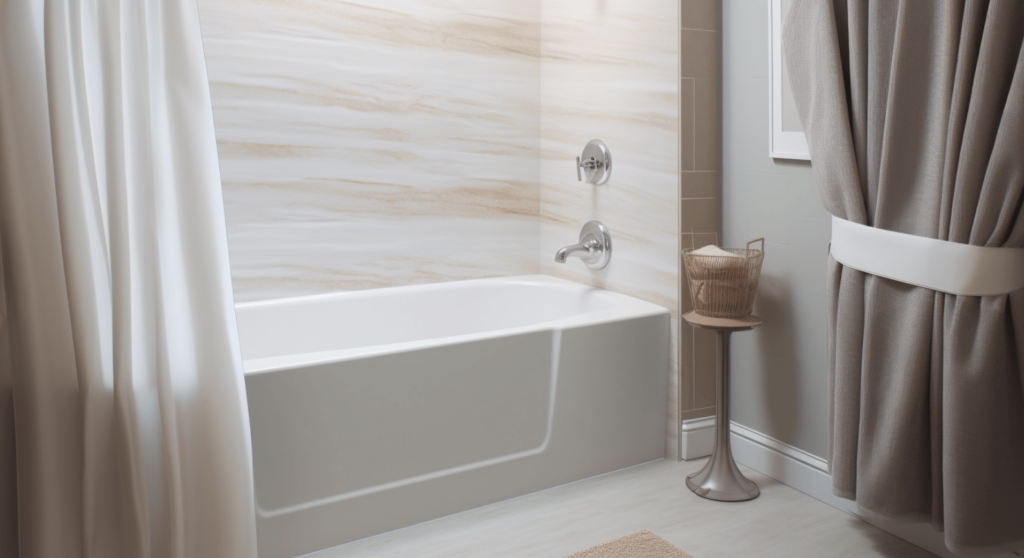When it comes to setting up your bathroom, understanding the difference between a shower curtain and a shower liner is crucial. These two items, while often used interchangeably, serve different purposes and have distinct features. This guide aims to provide a comprehensive understanding of shower curtains and liners, helping you make an informed decision for your bathroom setup.
What is a Shower Curtain?
Definition and Purpose
A shower curtain is a bathroom accessory hung around a shower or bathtub. Its primary purpose is to provide privacy and contribute to the bathroom’s overall aesthetic appeal. Shower curtains are usually hung on the outside of the tub or shower base.
Common Materials Used
Shower curtains come in a variety of materials, each offering a unique look and feel. Some of the most common materials include:
- Polyester: Known for its durability and easy maintenance. It’s resistant to shrinking and wrinkling, and it dries quickly.
- Cotton: Offers a soft, luxurious feel and is often used in high-end shower curtains. However, it absorbs water and requires a liner to prevent mold and mildew.
- Linen: A sturdy, luxurious material that’s more absorbent and faster-drying than cotton. It’s often used in high-end shower curtains and also requires a liner.
- Vinyl: A water-resistant and affordable material. It’s easy to clean but not as environmentally friendly as other options.

What is a Shower Liner?
Definition and Purpose
A shower liner is a protective layer that hangs inside the tub or shower base. Its primary purpose is to prevent water from splashing out of the shower or tub, protecting the bathroom floor and keeping it dry. Unlike shower curtains, shower liners are more about functionality than aesthetics.
Common Materials Used
Shower liners are typically made from water-resistant materials. The most common ones include:
- Polyester: This is a popular choice due to its water-resistant and affordable nature. It’s also easy to clean, as most polyester liners are machine washable.
- Vinyl: Vinyl liners are highly water-resistant and easy to clean. They are generally cheaper than polyester liners, but they are not as environmentally friendly.
Material Comparison
When choosing between different shower curtains and liners, the material is a crucial factor to consider. Different materials offer varying levels of durability, water resistance, ease of cleaning, and lifespan. Here’s a comparison table:
| Material | Durability | Water Resistance | Ease of Cleaning | Average Lifespan |
|---|---|---|---|---|
| Polyester | High | High | Easy (Machine washable) | 2-3 years |
| Vinyl | Medium | Very High | Easy (Wipe clean) | 1-2 years |
| Cotton | Medium | Low (Requires liner) | Moderate (Machine washable, but may shrink) | 2-3 years |
| Linen | High | Low (Requires liner) | Moderate (Machine washable, but may shrink) | 3-4 years |
| Hemp | High | Medium (May or may not require liner) | Moderate (Machine washable) | 4-5 years |
| Silk/Satin | Low | Low (Requires liner) | Difficult (Usually requires professional cleaning) | 1-2 years |
Cost Comparison
The cost of shower curtains and liners can vary significantly depending on the material. Here’s a comparison table to give you an idea of the average cost range for each material:
| Material | Average Cost Range |
|---|---|
| Polyester | $10 – $50 |
| Vinyl | $5 – $20 |
| Cotton | $20 – $80 |
| Linen | $50 – $150 |
| Hemp | $70 – $100 |
| Silk/Satin | $100 – $300+ |
Remember, these are rough estimates, and the actual cost can vary based on the specific product, its size, design, brand, and where it’s purchased from.
Environmental Impact
When choosing a shower curtain or liner, it’s worth considering the environmental impact of the material. Some materials are more eco-friendly than others. For instance:
- Polyester: While polyester is not biodegradable, it is often recyclable. Some manufacturers also offer polyester curtains and liners made from recycled materials.
- Vinyl: Vinyl is not biodegradable and can release harmful chemicals when incinerated. However, some types of vinyl are recyclable.
- Cotton: Cotton is biodegradable and renewable. Organic cotton options are also available, which have a lower environmental impact than conventional cotton.
- Linen: Linen is made from flax, a renewable resource. It’s also biodegradable and recyclable.
- Hemp: Hemp is a sustainable and biodegradable material. It grows quickly, requires little water, and doesn’t need pesticides.
Cleaning and Maintenance

Keeping your shower curtain or liner clean is essential not only for the overall hygiene of your bathroom but also for extending the lifespan of these items. Here’s how to clean and maintain shower curtains and liners based on their material:
- Polyester: Polyester curtains and liners are generally machine washable, making them easy to clean. Use a gentle cycle and mild detergent. Hang them up to dry. Avoid using bleach as it can weaken the fabric and cause discoloration.
- Vinyl: Vinyl liners are not machine washable. Instead, wipe them down with a damp cloth and a mild detergent. For stubborn mold or mildew, a solution of vinegar and water can be effective. Rinse thoroughly and hang to dry.
- Cotton and Linen: These can be machine washed on a gentle cycle with mild detergent. However, they should be washed separately from other items to prevent color bleeding. They should also be hung up to dry immediately to prevent wrinkles.
- Hemp: Hemp curtains can be machine washed in cold water on a gentle cycle. Use a mild detergent and avoid bleach. Hang to dry.
- Silk/Satin: These materials are delicate and may require professional cleaning. If machine washing is necessary, use a gentle cycle and a detergent suitable for delicate fabrics. Do not use bleach or harsh detergents.
Remember to replace your shower curtain or liner if you notice persistent stains, mold, or mildew that doesn’t come out with cleaning.
Customization
Shower curtains offer a great opportunity for customization. They come in a wide range of colors, patterns, and designs, allowing you to express your personal style and complement your bathroom decor. Some manufacturers even offer custom-designed shower curtains. You can choose a design that matches your bathroom tiles, paint, or accessories. You can also opt for a bold, contrasting design to make your shower curtain a focal point in the bathroom.
For an even more personalized touch, consider a photo shower curtain. Some companies allow you to upload your own photo or design to be printed on the curtain. This can be a fun way to showcase a favorite image or create a unique gift.
Accessibility Considerations
When it comes to accessibility, the choice between a shower curtain and liner can have several implications. Here are some factors to consider:
- Privacy: Shower curtains provide more privacy, which can be important in shared living situations. They are also easier to open and close for people with mobility issues.
- Ease of Use: Shower liners are typically lighter and easier to maneuver, which can be beneficial for people with limited strength or mobility.
- Safety: Shower liners can help keep water inside the shower or tub, reducing the risk of slips and falls on wet bathroom floors.
- Maintenance: Some materials and designs may be easier to clean and maintain than others. For example, a machine-washable polyester curtain or liner may be a more convenient choice for someone with limited mobility than a material that requires hand washing or professional cleaning.
Common Shower Curtain and Liner Questions
Over the years, we’ve received numerous questions about shower curtains and liners. Here are answers to some of the most common ones:
- Can I use a shower curtain without a liner?
Yes, but it depends on the material of the curtain. Water-resistant materials like polyester and vinyl can be used without a liner. However, absorbent materials like cotton and linen should be used with a liner to prevent water damage and mold growth. - Can a shower liner be used as a curtain?
Yes, a shower liner can be used as a curtain, especially if it’s made of a decorative material like polyester. However, keep in mind that liners are typically thinner and less opaque than curtains, so they may not provide as much privacy. - How often should I replace my shower curtain or liner?
This depends on the material and how well it’s maintained. On average, a shower curtain or liner should be replaced every six to twelve months. However, if you notice mold, mildew, or persistent stains, it should be replaced sooner. - How do I prevent mold and mildew on my shower curtain or liner?
The best way to prevent mold and mildew is to keep your shower curtain or liner clean and dry. After each shower, spread the curtain or liner out to help it dry more quickly. Regular cleaning can also help prevent mold and mildew growth.
Conclusion
Understanding the difference between a shower curtain and a liner can help you make the best choice for your bathroom. While shower curtains are often chosen for their aesthetic appeal, liners are a functional necessity that keeps water where it belongs – in the shower or tub. Don’t be afraid to experiment and find what works best for you. After all, your bathroom is a personal space that should be comfortable, functional, and pleasing to you.

Colby Armstrong
Colby Armstrong, born and raised in Vermont, is an inventive designer who developed a fascination for interior design and color coordination from a young age, influenced by his home decorator parents. An ardent hiker and nature enthusiast, Armstrong draws inspiration from natural elements and colors, incorporating them into his unique shower curtain designs.




